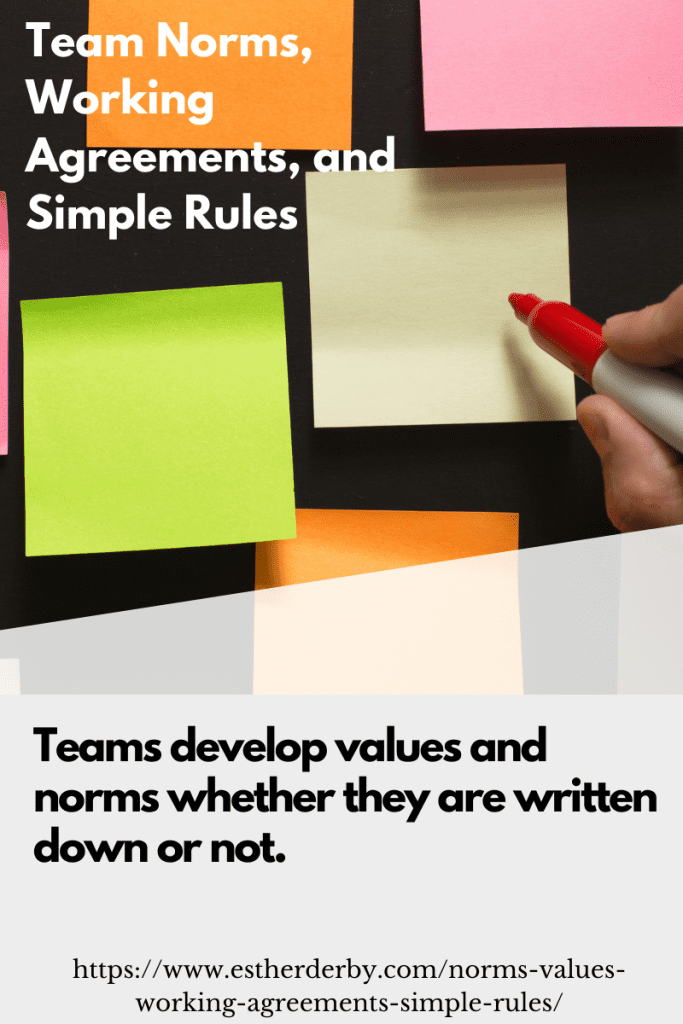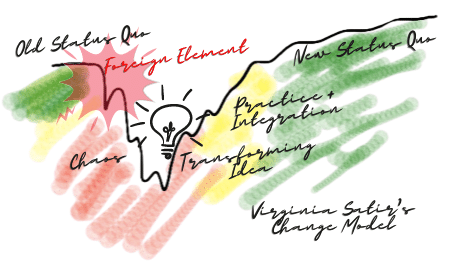What’s the purpose of team values, norms, working agreements, and simple rules?
Bob Sutton posted a piece on Team Guidelines that got me thinking how team values can be shaped and influenced. The guidelines–all Mom and Apple Pie–were handed down by a new boss for the team to follow. The list starts with “Show Respect.”
I find it ironic that the new boss is advocating treating people with respect. Arriving with a set of rules for other adults you’ve just met doesn’t feel respectful to me. I’m pretty sure that imposing rules won’t have the desired effect in shaping team values and behavior.
Modeling behavior, engaging the group in discussion about patterns of interaction, yes. Coming in with the rules like a kindergarten teacher–not so much. (See my post For Managers: 8 Ways to Build Trust, 3 to Break It for concrete ways to build stronger relationships.)
But the post got me thinking about how team values develop, and what teams can do to shape them.
How Team Values Develop
Teams develop values and norms whether they are written down or not.

Teams build up a pattern of interaction and implicit understandings of what people can do, should do, should not do, must and must not do in various situations. Often, the patterns form without much thinking about the implications. Team norms form around where people sit in meetings, or acceptable late arrival, and whether someone should bring cookies on Tuesdays.
But you don’t have to leave it to chance. Effective teams have a shared approach to work (though not a rigid process). They explicitly define working agreements about “how we do things.” Team agreements evolve to address both challenges and aspirations. Teams find a way to talk about what matters and decide how they’ll act out those priorities day to day.
The process of developing agreements accomplishes (at least) three things:
- The task of making agreements is a rehearsal for future decision-making
- Allows everyone in the group to express what is important in working together
- Establishes precedent for talking about “how we work together.”
Different sorts of agreements serve different purposes.
Reaching collaboration and high performance is possible without explicit agreements. It’s much easier (and more likely), however, for a team to reach high performance when they pay attention to the pattern they want to create and use these tools to help shape the pattern.
Teams should focus on the following areas when trying to clarify and solidify their values and attitudes:
Team Values
Team values are statements of what people hold as important. Often, teams make a list of nouns to hold their values. For, example, Courage, Collaboration, Respect. Team values may guide behavior, but are not, in themselves, actionable. Values become more actionable when teams discuss what each looks like in various circumstances. Discussion makes values concrete and contextual.
Values often represent the espoused beliefs in the organization–which don’t always match the values in action.
Example: Balance work and life. (But pay attention to what really happens.)
Team Norms
Norms are informal, often implicit standards of behavior that develop from the interactions of the group. These develop naturally. Some norms may be shaped by stated values and agreements. But others emerge overtime without conscious shaping.
Example: (By observing the group, we can deduces that…) It’s acceptable to be late for meetings or Men interrupt women, but not vice versa.
Ground Rules
Ground Rules are statements of expected behavior for specific times, places, and situations, for example in a retrospective, planning session, or other meeting.
Example: (Posted in the meeting room) Don’t interrupt each other.
Working Agreements
Working agreements are protocols that the group develops and agrees to follow. The protocols aim to forge commitment and a shared approach that will help the team meet their goal.
Example: Code is *done* when all programmer and acceptances tests pass, the customer accepts the story, and the code is checked into the development branch.
Simple Rules
Simple Rules are short aspirational statements. They’re intended to guide interactions and decision making within the group and across other groups within the organization. Simple Rules aren’t specific to a context. They generalize across many situations, and make values actionable. Simple Rules aim to bring coherence across the organization.
Example: Use every failure as an opportunity to learn.
How to Put These to Use
All of these represent social contracts between team members. Effective teams use one or more of them to create a desired pattern of interaction and results. The goal is tp enhance quality of both work life and results.
Some teams find it useful to have both simple rules (which help make values actionable) and working agreements (which address specific practices).
For both simple rules and working agreements, the list should be…
- focused on amplifying desired patterns of behavior
- aimed at helping the team achieve their task and team-work goals
- generalizable
- minimum specifications
- short: no more than seven items on each list (fewer than seven is even better)
Many teams I meet have some variety of agreements about how to act. The groups that do best have a short list and refresh it as needed. I visited one group that had a list of 20 team rules. That’s too many for anyone to remember. And such a long list is indicative of a different issue–probably that the group members hadn’t developed common language around practices and had very different mental models of how software development works.
Upholding Team Agreements
In their book The Wisdom of Teams, Jon Katzenbach and Douglas Smith make a keen observation about team values and attitudes:
“However they arise, such rules test a group’s own credibility. For example, if everyone agrees to make team meetings a top priority and then members fail to show up, it signals that the group may not be able to manage even the simplest of details, let alone conquer its performance challenges. The rules must be enforced. One team we know decided on total confidentiality to encourage open discussion. Early on a member violated the rule by talking to outsiders. When the rest of the team learned that the leader had gently, but firmly, reprimanded the offender, team discussions became even more open, free-wheeling, and, ultimately, creative.”
I’m not sure I’d go quite so far. I’d first ask, Why?
Especially in the meeting example mentioned by Katzenbach and Smith, there are plenty of reasons people arrive late or miss meetings. It is a signal for a conversation, that may results in adjusting the environment or the ground rule.
Make Sustainable Agreements
I’ve also seen new groups make agreements that are neither realistic nor sustainable.
Rather than enforce them, calibrate them to the environment and human frailties. Having a list of unattainable aspirations breeds cynicism. For example, I very seldom meet a well-functioning group that has zero interruptions–though may groups have that as a rule. Many perfectly happy and productive groups interrupt and talk over each other. They finish each others thoughts, build on the germ of an idea. What matters is whether there’s a pattern. When the number of times men interrupt women is dramatically outnumbers the reverse, collaboration suffers. When some members feel quashed by interruptions from a senior person, that’s a problem.
I’ve also seen some groups go overboard. I visited a group that had a list of 20 ground rules. That was too many to keep track of. I wondered what had happened in the past that made people want to control so much in the present. The chance for a violation goes up with the number of rules. Better to start with a handful and let them become habit. Then look at how the team is working and make some new, aspirational ones(but keep them within the realm of possibility).
Not every group needs to have a list of team values, team norms, ground rules, working agreements, and simple rules. The point isn’t to explicitly govern all aspects of behavior.
And when you visit a group, don’t just look at the list of values and agreements. Look at the posted rules and then observe how people really act.









Team norms and working protocols are critical for a team to become highly performing. Unfortunately, few teams spend the time defining working protocols such as the ones you describe.
If team members don’t know how to work together, they will waste precious time and energy getting things in motion.
I recently shared my thoughts in this topic.
http://analytical-mind.com/2011/04/11/the-strength-of-a-real-team-is-under-estimated/